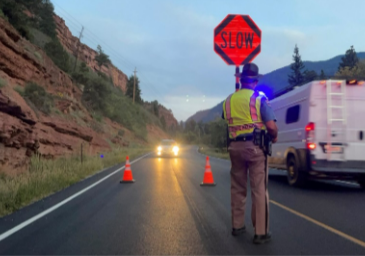Crash Responder Safety Week starts Monday, Nov. 14
News Release
Colorado - Last year there were over 1000 instances when drivers in Colorado crashed into the scene of an already existing crash putting first responders and others at risk. The upcoming Crash Responder Safety Week (Nov. 14-18) provides an opportunity to recognize all those who are part of the traffic incident management (TIM) response community, including law enforcement, medical personnel and tow truck drivers. These emergency responders work to help save lives at the scene of traffic crashes, but are put in harm's way by oncoming vehicles. Traffic-related incidents are the leading cause of death for on-duty law enforcement officers, fire, EMS, maintenance workers, and tow/recovery professionals.
According to preliminary data from CDOT, in 2021 there were 1153 reported secondary crashes on Colorado roads resulting in 588 injuries and 10 deaths. Such crashes happen when a vehicle runs into an already existing traffic crash on the roadway. These secondary crashes can be prevented if drivers slow down and use caution when approaching a crash scene.

During Crash Responder Safety Week, the Colorado Department of Transportation, the Federal Highway Administration, the Colorado State Patrol, the National Highway Safety Administration, AAA Colorado, and the Colorado State Committee on First Responder Safety will work together to raise awareness about the importance of using caution near traffic incidents along Colorado roadways. In a special proclamation, Governor Jared Polis recently proclaimed October 6, 2022 as Protect Our First Responders Awareness Day in Colorado.
Drivers are reminded that Colorado’s Move Over Law requires drivers to move over a lane and/or slow down when approaching stopped emergency or maintenance vehicles. The law stipulates that if a driver is unable to move at least one lane away from the stationary emergency vehicle, the driver must slow down to at least 25 miles per hour on roadways with a speed limit below 45 miles per hour. On roadways with speed limits 45 miles per hour or more, motorists must slow down to 20 miles per hour less than the posted speed limit. Drivers that fail to slow down or move over commit the crime of careless driving, a class 2 misdemeanor traffic offense that can result in up to 90 days in jail and a fine of up to $300.
Across the country, 65 emergency responders working on the roadway were struck and killed in 2021. Here in Colorado, a South Adams County Fire Department Firefighter was severely injured last January in a crash on Interstate 76 while working on an earlier two-vehicle collision. The firefighter was inside a stopped fire truck, responding to a highway crash, when a driver struck both an ambulance and the fire truck. In Colorado, 11 State Patrol Troopers have lost their lives after being struck by passing motorists. Countless others have been left with life altering injuries after being struck while responding to a traffic incident.
“These deaths and life changing injuries should not happen and are easily prevented,” said Chief Matthew C. Packard of the Colorado State Patrol. “When drivers see law enforcement officers and other first responders working on the road, it is the law to move over and give them a safe space to do their jobs. We need to keep our officers and responders safe in order to keep drivers safe, too. Let’s work together so that these devastating incidences don’t continue to happen.”
In an average month, Colorado emergency crews respond to 2,088 traffic incidents. CDOT and its partners are committed to improving traffic incident management so incidents can be detected, responded to, and cleared so that the flow of traffic may be restored as safely and quickly as possible. You can learn more about Colorado’s efforts by visiting ColoradoTIM.org.
Know Before You Go
Travelers are urged to “know before you go.” Gather information about weather forecasts and anticipated travel impacts and current road conditions prior to hitting the road. CDOT resources include:
- Road conditions and travel information: COtrip.org
- Download the COtrip Planner app: bit.ly/COtripapp
- Sign up for project or travel alerts: bit.ly/COnewsalerts
- See scheduled construction lane closures: bit.ly/laneclosures
- Connect with @ColoradoDOT on social media: Twitter, Facebook, Instagram and YouTube.
Remember: Slow For The Cone Zone
The following tips are to help you stay safe while traveling through maintenance and construction work zones.
- Do not speed in work zones. Obey the posted speed limits.
- Stay Alert! Expect the unexpected.
- Watch for workers. Drive with caution.
- Don't change lanes unnecessarily.
- Avoid using mobile devices such as phones while driving in work zones.
- Turn on headlights so that workers and other drivers can see you.
- Be especially alert at night while driving in work zones.
- Expect delays, especially during peak travel times.
- Allow ample space between you and the car in front of you.
- Anticipate lane shifts and merge when directed to do so.
- Be patient!
Download the COtrip App!
The new FREE COtrip Planner mobile app was designed to meet the growing trend of information on mobile and tablet devices for the traveling public. The COtrip Planner app provides statewide, real-time traffic information, and works on mobile devices that operate on the iOS and Android platforms. Visit the Google Play Store (Android devices) or the Apple Store (iOS devices) to download!
